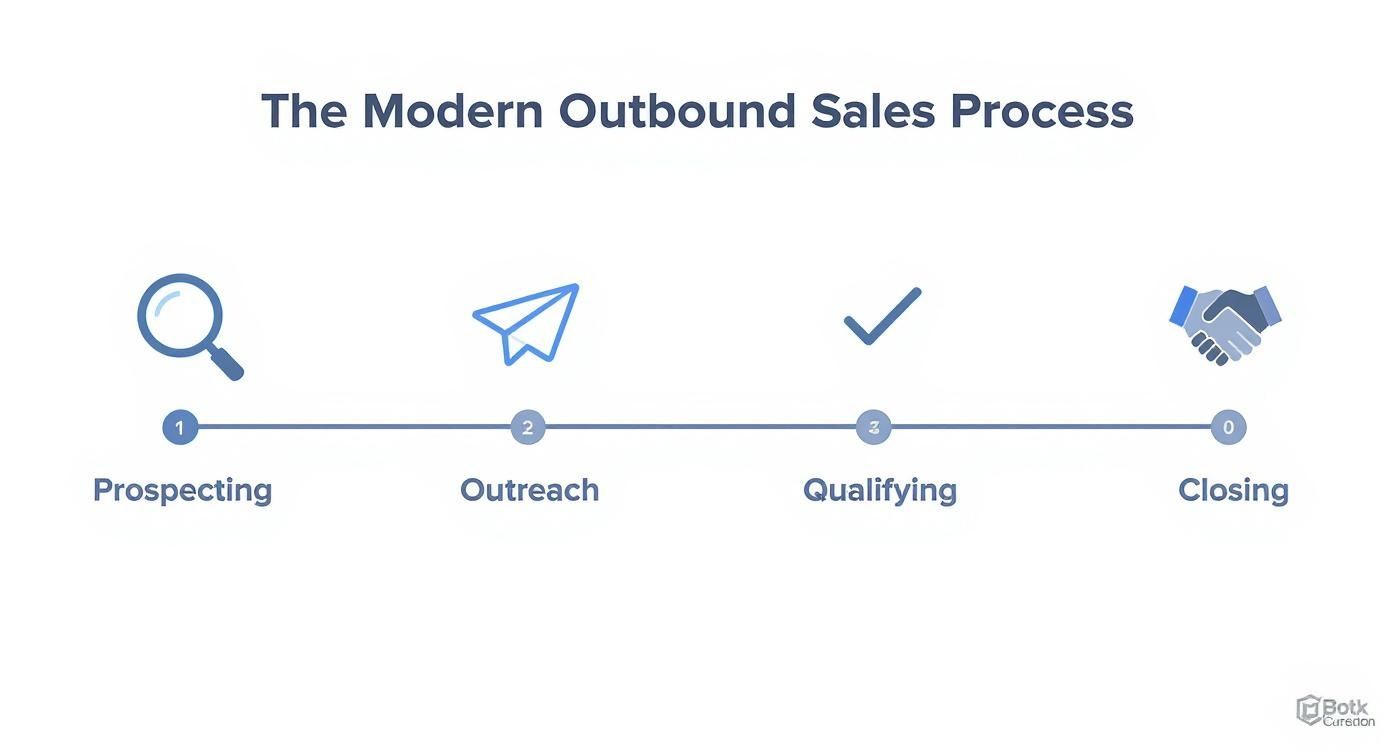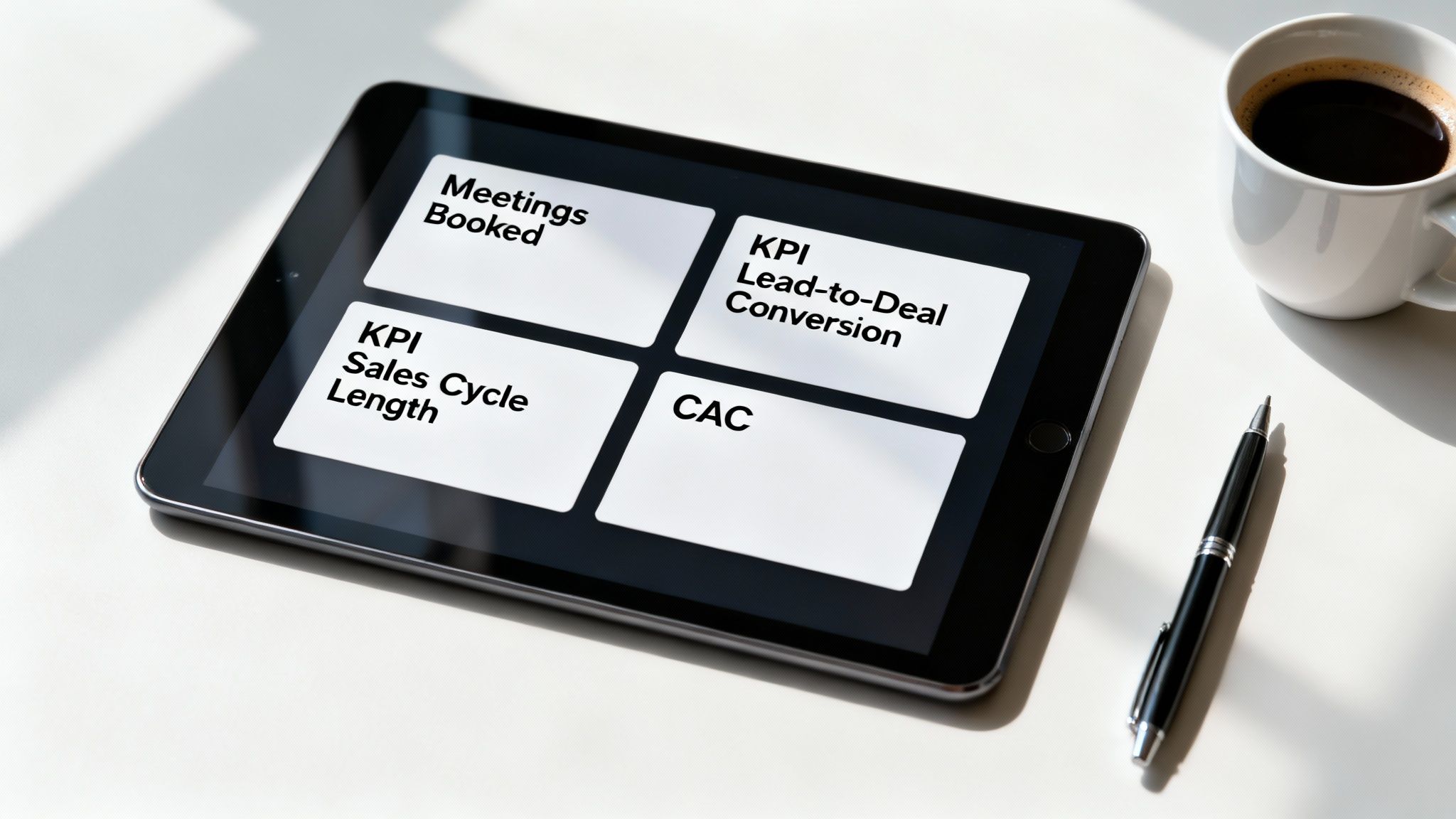Mastering the B2B Sales Funnel for Predictable Growth
A practical guide to the B2B sales funnel. Learn to build, measure, and optimize your funnel with proven strategies for converting leads into...
What is outbound sales? This guide breaks down the process, channels, and metrics that help B2B companies drive predictable revenue and sustainable growth.
Outbound sales is a proactive approach. Instead of waiting for customers to find you, your sales team initiates contact with potential buyers who fit a specific profile. Think of it as a treasure hunter with a map—you know what you're looking for and where to find it. This direct method puts you in control of building your sales pipeline.

Simply put, outbound sales is the process of actively seeking out potential buyers. It's the opposite of inbound, where you attract a broad audience and hope the right leads come to you. With outbound, your team identifies high-value prospects and reaches out directly through channels like email, phone calls, or social media.
This method gives your business total control over who you talk to and when. It’s a strategic system for starting valuable business discussions, especially for B2B companies trying to enter new markets or land major accounts. Understanding the key differences between inbound and outbound marketing is a great first step to grasping its unique power.
Despite shifts in buying behavior, outbound sales remains a vital growth strategy. New research shows that 78% of senior decision-makers consider it an important part of their strategy, with 39% calling it a 'core growth engine' for hitting revenue targets. The main reasons companies rely on outbound are to speed up slow sales cycles and gain a foothold in new customer segments.
Modern outbound isn't about the aggressive, spray-and-pray tactics of the past. It’s about precision and relevance. The goal is to build a predictable revenue stream by consistently filling your sales funnel with qualified opportunities.
The core idea is simple: if you know exactly who your ideal customer is, why wait for them to find you? Outbound sales lets you go directly to them with a message that solves their specific problems.
This proactive approach is critical for any business that wants to scale reliably instead of leaving growth to chance. To learn more, check out our complete guide on inbound vs outbound sales.
A successful outbound sales strategy isn't just a series of random cold calls and emails. It's a repeatable process, a clear roadmap that guides a stranger toward becoming a customer.
This journey typically unfolds across four distinct stages. Each one builds on the last, creating a reliable engine for generating pipeline. Master this process, and you’ll have an outbound machine. Without it, reps waste time on bad leads and send inconsistent messages. Let's break it down.
Everything starts here. Prospecting is the research you do to find companies and contacts that fit your Ideal Customer Profile (ICP). The goal isn’t to build the biggest list, but the best list. A hyper-targeted list of 100 perfect-fit prospects is far more valuable than a generic list of 10,000.
Great prospecting goes beyond finding names and job titles. Today’s top teams look for specific buying signals—a company hiring for a key role, opening a new office, or announcing a funding round. This initial homework ensures your outreach is relevant from the start.
Once you have your curated list, it's time for outreach. This is where you start the conversation. The primary channels are personalized emails, strategic phone calls, and direct messages on platforms like LinkedIn. The key is personalization. Generic, copy-and-paste templates get deleted instantly.
A great outreach message doesn't sell a product; it starts a conversation about a problem. It shows you've done your research and believe you can offer genuine value.
Your only job in this stage is to capture your prospect’s attention, build credibility, and earn a response that gets the ball rolling.
When a prospect responds with interest, you move to the qualifying stage. This is the discovery phase. Your goal is to determine if there's a real opportunity by asking smart questions to understand their challenges, needs, and goals.
This isn’t an interrogation; it's a two-way conversation to see if there's a mutual fit. You need to confirm they have a problem you can solve, the authority to make a decision, and the budget to back it up. Proper qualification prevents you from wasting months chasing deals that were never going to close.
Finally, once a prospect is fully qualified and you've established a clear need, you enter the closing stage. This is where you formally present your solution, handle objections, and guide the prospect toward a final decision.
If you executed the first three stages well, closing should feel like the natural conclusion to a helpful conversation. You’ve already built trust and established value, making these final steps much smoother.
Once you know who you're targeting, the next question is how to reach them. The right channel makes your outreach feel helpful and persistent. The wrong one makes you just another distraction.
Modern outbound sales relies on three core channels. Each has its own strengths, but the magic happens when you blend them into a unified approach that builds recognition and earns a response.
Personalized Email: This is the workhorse of outbound. It lets you deliver a well-researched, value-driven message directly to your prospect's inbox. The keyword is personalization; a message that mentions a specific challenge or company event is hard to ignore.
Strategic Cold Calling: The cold call is far from dead—it has evolved. Today, it’s about a quick, focused conversation to add a human touch to an email you’ve already sent. It’s still the most direct way to get instant feedback.
Modern Social Selling: For B2B, platforms like LinkedIn are invaluable. Social selling is more than sending connection requests. It's about engaging with a prospect's content and building familiarity before you make a direct ask.
To get the most from your efforts, think about how these channels work together. Learning from successful omni-channel marketing strategies can provide a significant advantage. A strong approach always combines multiple channels into a structured plan.
This is where the "outreach" stage of the sales process comes into play, bringing these channels together to engage the prospects you've researched.

As you can see, effective outreach is the logical next step after you've completed your prospecting.
Random acts of outreach don't work. The best outbound teams use a sales sequence—a pre-planned series of touchpoints across different channels over a set period. This structured approach prevents leads from falling through the cracks and makes your follow-up persistent without being pushy.
A simple sequence might start with an email, followed by a call a few days later, and then a LinkedIn connection request. Using data to perfect the timing is even better. To learn how to time your outreach, check out our guide on using https://salesmotion.io/blog/b-2-b-intent-data to spot buying signals.
A well-designed sales sequence builds momentum. Each touchpoint—whether it's an email, call, or social interaction—reinforces the last, making you a familiar name instead of just another stranger.
Here’s a sample of a simple 10-day, multi-channel sequence. It’s designed to get a prospect’s attention without overwhelming them. Notice how it methodically builds awareness and offers multiple ways to engage.
| Day | Action/Channel | Objective |
|---|---|---|
| 1 | Personalized Email | Introduce value, reference a specific trigger or pain point. |
| 3 | LinkedIn Connection | Build familiarity and establish a professional connection. |
| 5 | Follow-Up Email | Provide additional value (e.g., a case study or resource). |
| 7 | Cold Call | Briefly follow up on the email, aim to start a conversation. |
| 10 | Break-Up Email | One last value-add, leave the door open for future contact. |
This kind of structured plan transforms your outreach from isolated shots in the dark into a coordinated, intelligent campaign designed to get a response.
Generic, one-size-fits-all messages are the fastest way to get your email deleted. Today’s buyers expect you to know something about them. But how do you personalize outreach for hundreds of prospects without working around the clock?
The answer is to work smarter, not harder, by shifting to signal-driven outreach.
This modern approach moves beyond static data like job titles and company size. Instead, it focuses on timely data triggers—or signals—that create a compelling reason for you to connect right now. These signals are the key to crafting a powerful "Why you, why now?" message that cuts through the noise.
What exactly are these signals? Think of them as real-time events that indicate a potential need within a target account. They are relevant conversation starters for your prospect's world.
Here are a few key examples of powerful outreach signals:
The goal is to transform a cold outreach into a warm, relevant conversation. Instead of saying, "Here's what my product does," you're saying, "I saw you're focused on [their priority], and here's how we can help you achieve that."
This strategy is essential. Modern outbound is highly personalized, and more than 60% of B2B appointments are still scheduled through this kind of proactive outreach. This move toward targeted, signal-based messaging is a core part of any effective Account-Based Marketing (ABM) strategy.
Manually tracking these signals across hundreds of accounts is impossible. This is where account intelligence platforms come in, acting as your automated research team. They monitor thousands of sources to find these crucial signals for you.
Here’s how a platform like Salesmotion surfaces these triggers in a clear, actionable dashboard.

This dashboard instantly highlights key company events, like funding rounds and technology changes, so reps can act fast. Instead of losing hours to manual research, your team gets real-time alerts that can feed directly into their outreach.
These tools don’t just find raw data; they provide the context that helps reps connect a signal to a specific customer pain point. This is the secret to scaling meaningful connections and building a pipeline based on relevance. To make this process even more efficient, it's crucial to find the right outbound sales software that automates this research and fits into your workflow.

If you're not measuring your outbound sales efforts, you're flying blind. It's easy to get lost in vanity metrics like emails sent or calls made. Those numbers feel productive, but they don't tell you if your strategy is working.
To understand the health of your sales engine, you must track the key performance indicators (KPIs) that directly connect your team's activity to revenue.
Despite the hype around inbound, a recent report found that 80% of top sales teams still lean heavily on outbound as a core growth strategy. Their secret? They obsessively track metrics like sales cycle length and close rates to make smarter decisions. You can read the full report about outbound sales strategies here.
Let's focus on the four KPIs that truly move the needle.
Tracking these specific metrics gives you an honest picture of your performance. They help you pinpoint where your process is breaking down and make data-backed decisions that improve your bottom line.
Here are the essential outbound KPIs for your dashboard:
Meetings Booked: This is your frontline indicator. It’s the most immediate signal of whether your prospecting and outreach are effective. This metric directly measures your team's ability to turn cold contacts into warm conversations.
Lead-to-Deal Conversion Rate: This KPI measures the quality of the meetings you're booking. A high number of meetings but a low conversion rate is a red flag. It usually points to a problem with your qualification process or a mismatch with your Ideal Customer Profile (ICP).
Sales Cycle Length: How long does it take to get a prospect from the first meeting to a signed deal? A long sales cycle can mean there’s friction in your process or your messaging isn't resonating.
Customer Acquisition Cost (CAC): This is the ultimate bottom-line metric. It calculates the total cost of your sales and marketing efforts to acquire one new customer, giving you a clear view of your outbound engine's financial efficiency.
Measuring these four KPIs turns your outbound sales from a guessing game into a science. They provide the actionable insights needed to refine your targeting and messaging for predictable growth.
By keeping a close eye on these indicators, your team can move beyond being busy and start being productive. To dig deeper into this, check out our guide on other crucial lead generation key performance indicators.
Many outbound campaigns fail because they fall into the same few traps. The good news is these mistakes are preventable. If you know what they are, you can build a stronger sales motion from day one.
Let's break down the biggest pitfalls so you can sidestep them.
The single biggest reason outbound fails is a blurry or nonexistent Ideal Customer Profile (ICP). This is the classic "spray and pray" approach. When you try to sell to everyone, you connect with no one, resulting in generic messaging that wastes time on prospects who were never going to buy.
Your ICP needs to be razor-sharp. Get specific about the industry, company size, and job titles you're targeting. This focus is the foundation for writing relevant outreach that gets a response.
A vague ICP is the root cause of almost every other outbound mistake. If you don't know exactly who you're selling to, you can't possibly know what to say to them.
Prospects don’t care about your product’s features; they care about their own problems. A major pitfall is leading with a list of features instead of focusing on the business pain your solution solves. Your message must always answer the prospect's silent question: "What's in it for me?"
The fix is simple: frame everything around outcomes. Instead of saying, "Our software has an AI-powered analytics dashboard," try, "Our software helps teams like yours cut reporting time by 50%." One is about you, the other is about them.
Another critical error is giving up after one or two unanswered attempts. It’s easy to get discouraged, but the data is clear: it takes multiple touchpoints across different channels to cut through the noise. Persistence isn't just a virtue in modern outbound; it's a requirement.
Successful campaigns use a structured sequence of emails, calls, and social touches spread out over several days or weeks. Bailing early means you’re leaving potential deals on the table for a more tenacious competitor. A lack of response doesn't always mean "no"—it often just means your prospect is busy.
Diving into outbound sales can bring up a lot of questions. Let’s tackle some of the most common ones with practical, straightforward answers to help sharpen your strategy.
Not at all. They are fundamentally different.
Telemarketing is typically a high-volume, scripted numbers game aimed at consumers (B2C). The goal is a quick, transactional sale, often with little research.
Modern B2B outbound is a strategic function focused on targeting well-researched accounts. Instead of a single-channel approach, it uses a thoughtful mix of email, calls, and social touches to start conversations about solving specific business problems. The aim isn't a fast transaction; it's about building a relationship and guiding a prospect through a complex decision.
Yes, but the game has changed. The old-school approach of dialing down a random list with a generic pitch is dead. But a strategic cold call is more powerful than ever as part of a smart sequence.
It’s not really "cold" if you just sent a personalized email referencing a specific company signal. In that context, the call is a warm, human follow-up. It's your chance to start a real dialogue and book a meeting. It’s all about quality and timing, not just volume.
There's no single number—it depends on your goals, industry, and team size. That said, your budget will generally cover three key areas:
A great way to ground your budget is to calculate your Customer Acquisition Cost (CAC). Once you know what it costs to acquire a new customer, you can work backward to set a realistic budget that ensures your efforts are profitable.
Ready to stop guessing and start scaling your outbound with precision? Salesmotion gives your team the real-time account intelligence needed to craft compelling, "why now" messages that get replies and build pipeline. See how signal-driven sales really works.
A practical guide to the B2B sales funnel. Learn to build, measure, and optimize your funnel with proven strategies for converting leads into...
Discover outbound lead generation that builds a predictable pipeline with signal-driven targeting, personalized messaging, and measurable growth.
Build a winning go to market strategy framework. This guide breaks down the core components, steps, and metrics for a successful product launch.